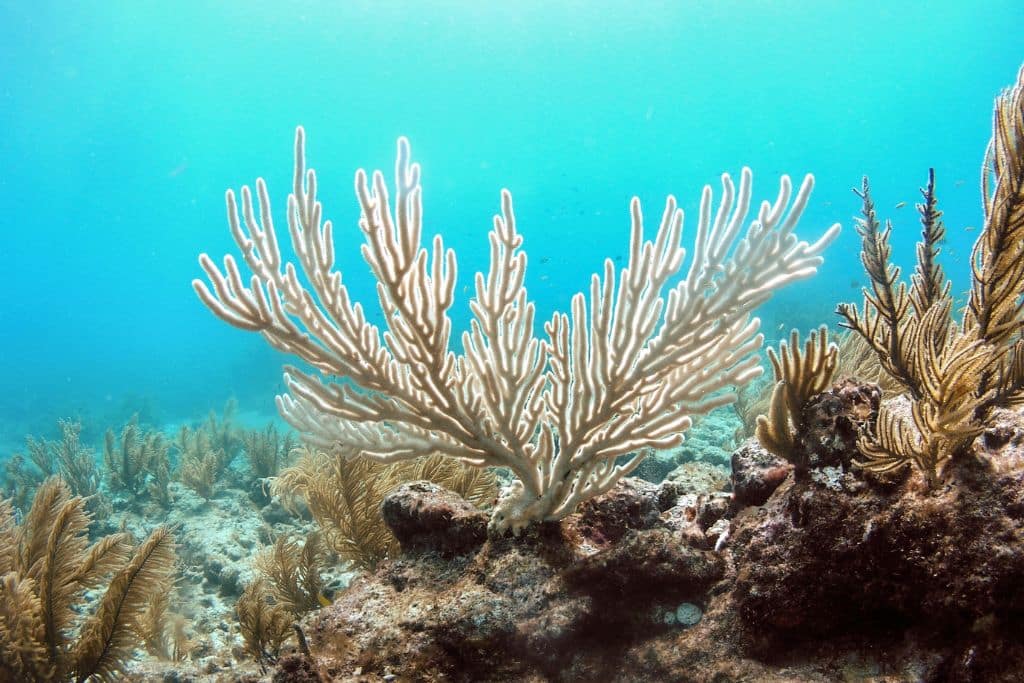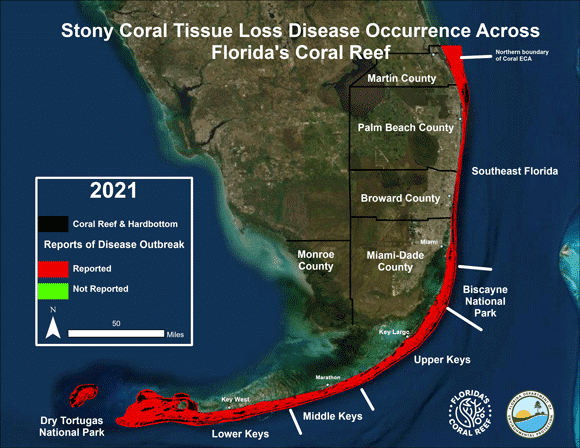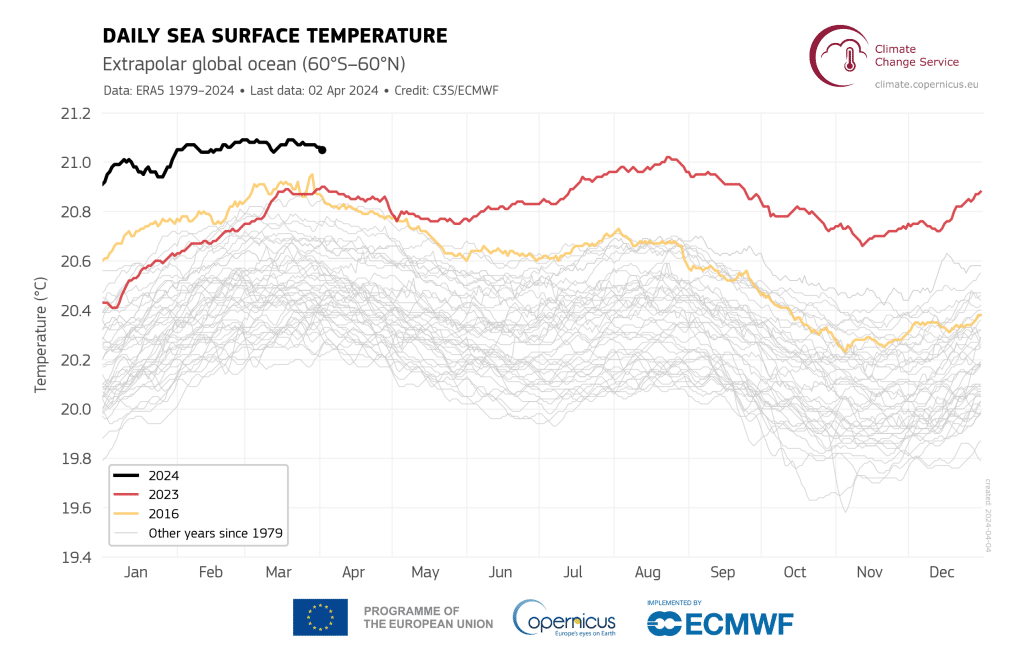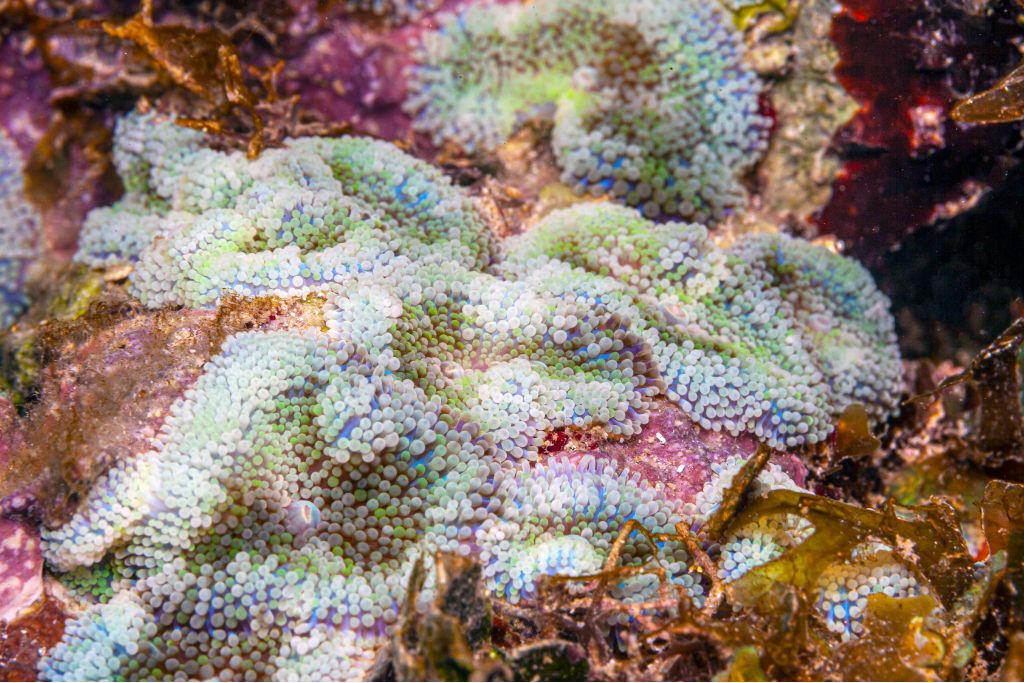With ocean acidification and climate impacts on the rise, Florida’s coral reefs have been under strenuous conditions due to bleaching events, pollution, and warming ocean temperatures. Over the past decade, the State of Florida has taken critical steps towards fighting coral reef decline through restoration projects and research. A recent award by Governor Ron DeSantis to the Coral Reef Restoration and Recovery Institute, their recovery efforts and partnerships will continue to expand.
—
Florida’s coral reef extends over 350 nautical miles (648.2 km) and is bordered by communities housing over 6 million people. Composed of stony coral and octocoral that make up versions of both barrier reefs and patch reefs along the coast, the reef offers a multitude of benefits for the local population and economy.
Coral reefs provide habitat for species crucial to commercial and recreational fisheries, serve as a pivotal site for biomedical research and education, and shield local shorelines from storms and wave erosion. They are also home to a diverse range of creatures and keystone species, which, unfortunately, draw the attention of tourists hungry for a closer look that often destroy the biodiversity and compromise the health of these already fragile ecosystems.
Humans are behind global warming, one of the main reasons why these coral reefs are disappearing at a heightened rate, especially in heavily populated areas like along the Florida coast. Global warming is contributing to rising ocean temperatures, leading to more frequent reef bleaching and disease events and the loss of coral reefs worldwide. On top of this, land-based sources of pollution and human impacts alter the course of these coral reefs, making it nearly impossible for a majority of these locations to bounce back and return to their original colorful state.
More on the topic: What Is Coral Bleaching?
How can we as a community combat this global issue and restore the quality and quantity of these beautiful reefs? With new funding and partnerships statewide, Florida’s reefs will be able to make a comeback from new innovative technology, restoration projects and expansion efforts, setting an example for other countries to follow.
‘Rainforests of the Sea‘
Corals are some of the oldest living animals found on our planet, supporting and hosting a rich web of life in our oceans. Florida’s coral reef – mostly based off of the state’s southeast coastline formation, stretching all the way past the Florida Keys – originated around 10,000 years ago, when sea levels rose and life returned to a normal state after the Ice Age.

Coral reefs are nicknamed the “rainforests of the sea” because of their diverse communities and coral skeletons that resemble trees, containing thousands of years of records and history. More than 25% of all marine species call coral reefs their home, including sponges, crustaceans, and fish. Corals are usually divided into two families: stony corals and octocorals, with more than 70 combined species found across Florida’s coral reef.
Reef growth is very slow and colonies are very specific on where they live and how they develop. Reefs require a solid structure for growth and attachment, clean waters with low amounts of nutrients, warm waters, and low to moderate wave action, which allows the ecosystem to disperse waste and provide oxygen to the reef. They are also dependent on salinity, depth, and currents.
More on the topic: Mass Coral Bleaching Event in Florida as Ocean Temperatures Exceed 100F
Florida Looking to Greatly Boost Restoration Efforts
In March 2024, Florida Governor Ron DeSantis announced that he will be awarding $9.5 million to Florida’s Coral Reef Restoration and Recovery Initiative, established in 2019 to ensure the state tackles infrastructure development and coral reef technology and capacity for long-term support and recovery, and will prioritize safeguarding and partnering with other organizations to protect Florida’s coral reefs.
“Safeguarding our coral reef is important both environmentally and economically and we will continue to support projects that keep this natural resource healthy,” he said.
The award includes specific coverage within the alliance initiative, including expansion of land-based propagation infrastructure impacting stony coral tissue loss disease, which was first reported in 2014 and has affected more than half of Florida’s reef-building corals. The coral outbreak has high rates of disease transmission and mortality, where a colony can be seen dead within only weeks to months after first signs of the tissue loss disease. Stony coral are known as the major reef architects so losing this species completely in Florida’s reef system will result in an entire ecosystem breakdown. By focusing on intervention and field trials, sampling and lab analysis as well as site monitoring and rescue efforts, Florida will be able to fight back against the epidemic and restore these colonies back to their original health.

The award also covers the expansion of research and development, coral restoration efforts and nurseries, and facilities to care for specific threatened species, such as the pillar coral. Other threatened reef species in Florida’s coral zone include the staghorn coral and the elkhorn coral, both siblings in the stony coral family. The action points listed will remain specific to different agency and organization regions in the state that aim to combat these goals with their unique knowledge, research laboratories and cooperation efforts, all of which will all receive dividends of the award to continue their research and expand their development capacity for coral reefs.
Race Against Time
Climate change, known as one of the greatest drivers of decline and extinction within all aspects of our global ecosystems, is also greatly impacting coral reefs. Harmful land-sea relationships – the combined effect of local land and sea-based human impacts on an environment like pollution harm and overfishing – are causing irreversible damage to corals. These measures include increasing water acidification, land-based pollution and rising fossil fuel emission, and warming oceans.
“The burning of fossil fuels has been the main driver of ocean warming since the 1970s… Corals are fine-tuned to their environment. Even small changes in temperature can stress a coral out. This can lead to coral bleaching”, explained Ove Hoegh-Guldberg, a professor of Marine Studies at the University of Queensland.
Coral bleaching events force corals to expel the algae from their tissues, which causes the loss of their vibrant colors and deprives the reefs of their main food source. This is where the name coral bleaching comes from.
Under normal conditions, coral reefs would have about two decades or less to recover between extreme or stressful events, such as disease or catastrophic storms. But under current conditions, things are different.
The frequency and intensity of events are rising due to climate change impacts, leaving these reefs vulnerable and without enough time to recover and reproduce. This will not only affect corals but also the diversity of marine life dependent on these colonies.
Corals can take years to reach sexual maturity, and some reefs can take thousands of years to fully form, so addressing these losses is urgent and pressing if we want to maintain coral reef ecosystems as we know them,” said Katie Barott, an assistant professor at the University of Pennsylvania studying how corals fare against climate change.

The warming of our oceans’ temperatures is not the only issue. Human activities produce overwhelming amounts of carbon dioxide that get sucked into our oceans. The heavy increase of carbon dioxide causes the ocean to become more acidic, which prevents coral polyps from producing their limestone skeleton. One long-term study at Florida Keys’ Looe Key reef published in 2023 found that warming ocean water is not just to blame for the decline in Florida’s coral reefs: “The 3 largest mass coral bleaching events occurred only in the years following increased land-based runoff.” This runoff, originating from the Everglades as part of a large drainage basin, brings agricultural fertilizer and excess nitrogen into the homes of reef colonies.
You might also like: Scientists Confirm Fourth Global Coral Bleaching Event Across 53 Countries
Vanishing Corals: Charting the Course for the Future
The warmer our planet and oceans become due to fossil fuels and climate change, the higher chance natural disasters and devastating events will strike globally.
“Getting to zero carbon emissions is absolutely essential for the survival of coral reefs into the future… we’re not going to have the amount of biodiversity and services from these ecosystems that a lot of people rely on, both for their cultural value as well as for nutrition,” said Barott.
This underscores the urgent need for global action to fight the climate crisis. As carbon emissions continue to rise, the delicate cycle of coral reef ecosystems hangs in the balance. In order to turn the tide and bring these important ecosystem leaders back to their original state, Florida, along with dozens of other nations and states, will have to boost their restoration and project efforts even further, increasing research, conservation efforts, and global outreach to both small and large-scale communities worldwide.
While some corals are adjusting and adapting to the harsh conditions, a majority will need human intervention to survive and bounce back. Only through land-sea policies and a drastic reduction in greenhouse gas emissions will coral reefs have a chance to survive.
Individual action matters, too.
Many local neighborhoods have the ability to help save these ocean ecosystems by reducing fertilizer input into the watersheds, which will improve sewage treatment and better management of stormwater runoff from the mainland. Properly disposing of household chemicals and paints, and even choosing sustainable seafood options when eating out can help reduce local threats to coral reef health.
Moreover, scientists have been working to identify the resilient coral species and develop methods to reintroduce corals into the ocean and use satellite data and surveys to give local residents information about their local reefs to understand how to better protect them.
This story is funded by readers like you
Our non-profit newsroom provides climate coverage free of charge and advertising. Your one-off or monthly donations play a crucial role in supporting our operations, expanding our reach, and maintaining our editorial independence.
About EO | Mission Statement | Impact & Reach | Write for us


















